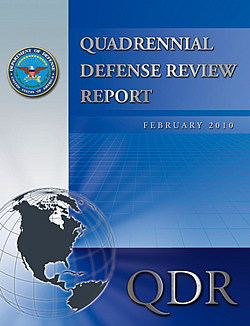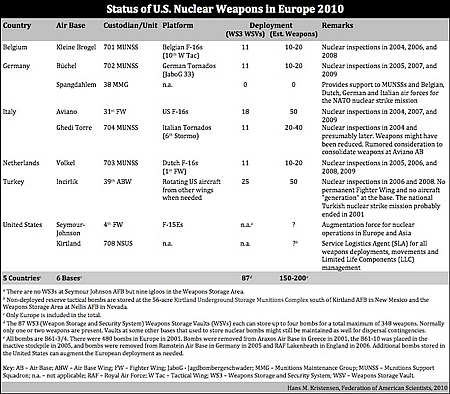Nuclear Posture Review to Reduce Regional Role of Nuclear Weapons
 |
| The Quadrennial Deference Review forecasts reduction in regional role of nuclear weapons. |
By Hans M. Kristensen
A little-noticed section of the Quadrennial Defense Review recently published by the Pentagon suggests that that the Obama administration’s forthcoming Nuclear Posture Review will reduce the role of nuclear weapons in regional scenarios.
The apparent reduction coincides with a proposal by five NATO allies to withdraw the remaining U.S. tactical nuclear weapons from Europe.
Another casualty appears to be a decision to retire the nuclear-armed Tomahawk sea-launched land-attack cruise missile, despite the efforts of the Congressional Strategic Posture Commission.
New Regional Deterrence Architectures
Earlier this month President Barack Obama told the Global Zero Summit in Paris that the NPR “will reduce [the] role and number of nuclear weapons in our national security strategy.” The reduction in numbers will initially be achieved by the START follow-on treaty soon to be signed with Russia, but where the reduction in the role would occur has been unclear.
Yet the Quadrennial Defense Review (QDR) published earlier this month strongly suggests that the reduction in the role will occur in the regional part of the nuclear posture:
“To reinforce U.S. commitments to our allies and partners, we will consult closely with them on new, tailored, regional deterrence architectures that combine our forward presence, relevant conventional capabilities (including missile defenses), and continued commitment to extend our nuclear deterrent. These regional architectures and new capabilities, as detailed in the Ballistic Missile Defense Review and the forthcoming Nuclear Posture Review, make possible a reduced role for nuclear weapons in our national security strategy.” (emphasis added)
There are two parts (with some overlap) to the regional mission: the role of nuclear weapons against regional adversaries (North Korea, Iran, and Syria); and the role of nuclear weapons deployed in Europe.
Rumors have circulated for long that the administration will remove the requirement to plan nuclear strikes against chemical and biological weapons from the mission; to limit the role to deterring nuclear attacks. Doing so would remove Iran, Syria and others as nuclear targets unless they acquire nuclear weapons. A broader regional change could involve leaving regional deterrence against smaller regional adversaries (including North Korea) to non-nuclear forces and focus the nuclear mission on the large nuclear adversaries (Russia and China).
An immediate consequence of the new architecture appears to be a decision to retire the nuclear Tomahawk sea-launched land-attack cruise missile (TLAM/N). According to a report by Kyodo News (see also report by Daily Yomiuri), Washington has informally told the Japanese government that it intends to retire the weapon. The 2009 Congressional Strategic Posture Commission report had recommended retaining the weapons, but neither the Pentagon nor the Japanese government apparently agreed.
| Nuclear Tomahawk To Be Retired |
 |
| The Obama administration has informally told the Japanese government that the nuclear Tomahawk cruise missile will be retired. The retirement appears to be part of a new regional deterrence architecture that enables a reduction of the role of nuclear weapons. |
.
A Nuclear Withdrawal From Europe?
The other part of the regional mission concerns the deployment of nuclear weapons in Europe, where the U.S. Air Force currently deploys 150-200 nuclear bombs at six bases in five NATO countries. Some of the TLAM/Ns also are earmarked for support of NATO, but are stored on land in the United States. The weapons are the last remnant of the Cold War deployment of thousands of tactical nuclear weapons to deter a Soviet attack on Europe. Similar deployments in the Pacific ended two decades ago and pressure has been building for NATO to finally end the Cold War.
Three of the five NATO countries that currently host the U.S. nuclear bombs on their territories are expected to ask for the weapons to be withdrawn, according to a report by AFP.
A spokesperson for the Belgian Prime Minister said that Belgium, German, and the Netherlands, together with Norway and Luxemburg, in the coming weeks will formally propose within NATO that “that nuclear arms on European soil belonging to other NATO member states are removed.”
Presumably, some coordination with Washington has taken place. Otherwise, if the NPR does not recommend a withdrawal from Europe, the five countries’ initiative will from the outset be in conflict with the Obama administration’s nuclear policy, which NATO likely will follow.
The European initiative would help the Obama administration justify a decision to withdraw the weapons from Europe by demonstrating that key NATO allies no longer see a need for the deployment. Extended nuclear deterrence would continue, as the QDR language underscores, but with long-range strategic weapons as it is done in the Pacific.
Other than the forthcoming NPR, the political context for the European initiative is NATO’s ongoing review of its Strategic Concept, scheduled for completion in November. The Obama administration might not want to preempt that review, so an alternative could be that the NPR concludes that the U.S. sees no need for the continued deployment of nuclear weapons in Europe but leaves it up to NATO’s new Strategic Concept to make the formal decision. In that case, the initiative by the five NATO countries could serve to formally start that process within NATO. (see comments by U.S. NATO Ambassador Ivo Daalder)
Whether that means a complete withdrawal from Europe now, a decision to end the NATO strike portion (a controversial Cold War mission that assigns nuclear weapons for delivery by Belgian, Dutch, German, and Italian aircraft) and consolidating the remaining weapons at one or two U.S. bases in Europe, or something else remains to be seen. But a reduction rather than complete withdrawal would achieve little.
Heated Debate
The debate over the deployment in Europe is in full swing, recently triggered by the new German government’s decision to work for a withdrawal.
A paper by Franklin Miller, a former top-Pentagon official in charge of the deployment in Europe, and former NATO head George Robertson calling the German position dangerous was rejected as old-fashioned thinking on the New York Times’ opinion pages by Wolfgang Ischinger, Germany’s former foreign deputy foreign minister and chairman of the Munich Security Conference, and Ulrich Weisser, a former director of the policy planning staff of the German defense minister.
And suggestions by some supporters of continued deployment that Eastern European countries oppose withdrawal have suffered recently with Poland’s Prime Minister Radek Sikorski calling for the reduction and elimination of non-strategic nuclear weapons, and a report from the Polish Institute of International Affairs in March 2009 that appeared to question the need for the nuclear deployment.
Status of U.S. Nuclear Deployment in Europe
The U.S. Air Force currently deploys an estimated 150-200 U.S. nuclear bombs in 87 aircraft shelters at six bases in five countries, a reduction from approximately 480 bombs in 2001. The breakdown by country looks like this:
 |
| Click image to download larger pdf-version. |
.
Additional Background: History of U.S. Nuclear Weapons in Europe
This publication was made possible by a grant from Carnegie Corporation of New York and Ploughshares Fund. The statements made and views expressed are solely the responsibility of the author.
A military depot in central Belarus has recently been upgraded with additional security perimeters and an access point that indicate it could be intended for housing Russian nuclear warheads for Belarus’ Russia-supplied Iskander missile launchers.
The Indian government announced yesterday that it had conducted the first flight test of its Agni-5 ballistic missile “with Multiple Independently Targetable Re-Entry Vehicle (MIRV) technology.
While many are rightly concerned about Russia’s development of new nuclear-capable systems, fears of substantial nuclear increase may be overblown.
Despite modernization of Russian nuclear forces and warnings about an increase of especially shorter-range non-strategic warheads, we do not yet see such an increase as far as open sources indicate.